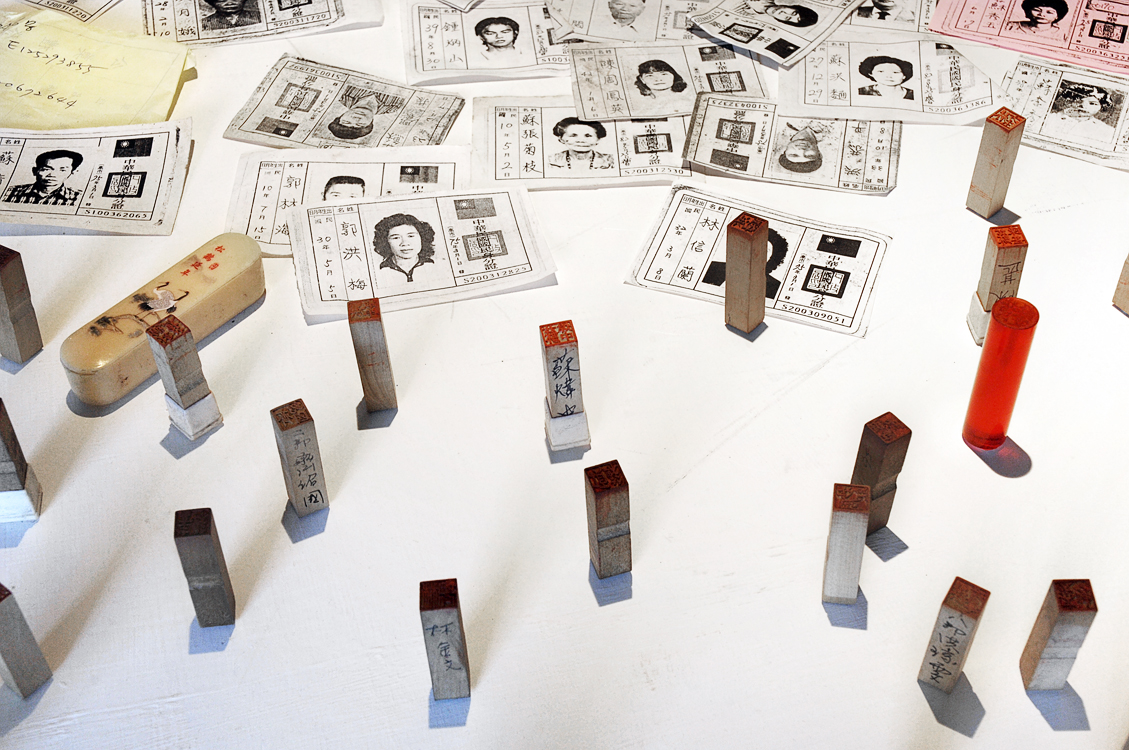在台灣的遷村事件中除了天然災害外,就是因應國家經濟發展計劃的開發。在經濟開發下的遷村事件,社會普遍的價值認定是捨棄個人價值來成全眾人之利的思維,當這成為計畫施作者的基本概念時,就會忽略地方過去百年來積累的人文歷史價值以及因此事件而就此改變的人生。
陳伯義的紅毛港影像計劃就是透過待拆遷的家來記錄這個聚落的人文風景,以家為單位拍攝他們遷出後遺留在家屋的東西與牆壁上的痕跡和窗外的風景。這次的創作首先思考家的價值,以攝影來展示漁村各家戶禁建後40年來的生活景觀,試著從日常用品的出席(遺留)與缺席(痕跡)來描繪時間歷程下的樣貌。其次藉由撿拾的遺物來召喚這些用品對使用者的故事,讓「勿忘影中事」的照片與「睹物思情」的遺物在這樣的展示上產生死而復生的敘述,連結了陳伯義在這個創作上對家的心念。雖然家園為了國家經濟發展犧牲了,但其中的糾結的情緒也化成了批判的力量,藝術家嘗試將崩毀的家屋與外部的工業景觀組合在一起,於是透過攝影打燈的手法將家屋內外的景色扁平的貼合在窗口,「窗景」是直接寫實的照片,但卻又充滿超現實感,如同這個遷村事件一樣荒謬又矛盾。
Apart from the damage done by natural disasters, another cause for relocation in Taiwan would be due to the projects related to national economic development. This type of relocation is usually deemed as a sacrifice of personal value for the greater good of the majority. However, when this type of thinking has become the rationale of the people that carry out the projects, they overlook the cultural and historical value formed throughout the centuries and of the people whose lives have drastically changed due to the projects.
This photographic project of Hongmaogang aimed to document the historic and cultural landscape of this community through those demolished homes. Taking each home as a unit, artist photographed the things left behind in the houses, the traces on the walls, and the views outside the windows. Chen Po-I had a couple of ideas about this project. The first was to think about the value of home. Through photography, he revealed the living environment of the households in the fishing village since the exclusion regulation was announced forty years ago, hoping to capture the progress of time in the presence (remains) and absence (traces). Secondly, by collecting the remnants, he conjured up stories about the users of these objects, creating a narrative that connected photos, which have been used to “remind people of past events,” and the things left behind, which “evoked nostalgic feelings when looked upon.” It also reflected my affections for home in this work. Although these homes were sacrificed for national economic development, the entangled feelings have also formed a critical force. Chen Po-I tried to combine the collapsed houses and the exterior industrial landscape. With the help of photographic lighting, the views outside the houses seemed to be flatly pasted onto the windows, turning these “window views” into photos that were simultaneously realistic and surreal, echoing the absurdity and contradictions in this relocation.
陳伯義 Chen Po-I
1972年生於台灣嘉義,曾從事過攝影教學及策展等工作,專長為攝影及海洋工程,作品曾被國立台灣美術館、高雄市立美術館、日本清里攝影美術館及私人單位典藏。目前就讀於國立成功大學水利及海洋工程研究所博士班。2013年曾以拍攝莫拉克颱風災區的《莫拉克‧南沙魯》,入圍第12屆台新藝術獎。
Born in 1972 in Chiayi, CHEN Po-I has been actively engaged in photography education and works as an exhibition curator under his professional specialty of photography and ocean engineering. Some series of his photographic works now have become part of the permanent collections of National Taiwan Museum of Fine Arts (Taiwan); Kaohsiung Museum of Fine Arts (Taiwan); Kiyosato Museum of Photographic Arts (Japan), and his works are also collected by private collectors. Chen is currently a PhD candidate at the Department of Hydraulic and Ocean Engineering at NCKU. In 2013, his photographic work Morakot Nansha-lu depicting the typhoon disaster area had won a nomination for the top fifteen productions in the 12th Taishin Arts Award.
陳伯義
關渡美術館
關鍵字
- 攝影
- 裝置
- 照片
- 窗
- 都更
- 廢墟
- 田野調查
- 光
藝術家談作品
那些不見的人去了哪啊!
那些不見的人去了哪啊!
評審談作品
獨特的廢墟美學。
入圍理由 Reason for Nomination
陳伯義外號「BB」,意思是他常常像警察一樣發出警告訊息,這種天生keep alert的性格,使他對環境非常敏感,各種風吹草動,立刻會引起他的注意,像「紅毛港」遷村這種重大事件,陳伯義一定趕到現場,拿起他的相機,用他精練的攝影手法,即時即地的拍攝現場各種有的沒有的。因為自我藝術文青的嚴格訓練,陳伯義善於「光」的操作,有「光」才有生命,陳伯義的作品非常光明清朗,非常振奮人心,也非常細膩敘述,這種對於「光」的嚮往追求,是陳伯義作品的深層內裡,也是貫串創作的最核心主旨,以「光」闡述,以「光」辯證世界,到哪裡都有「光」,當然也包括「紅毛港」。提名觀察人 ─ 李俊賢
CHEN Po-I’s nickname, “B.B.” is a reference to his penchant for issuing warnings, like a police whistle. His innate “keep alert” personality has sensitized him to his environment. Any wind of change attracts his attention. At any major event, such as the relocation of Hongmaogang Village, CHEN Po-I would arrive at the scene, camera in hand, to capture all various sundry details with his skillful photographic techniques. His rigorous and self-disciplined artistic training has made CHEN Po-I adept in manipulating light. When there is “light”, life exists. CHEN Po-I’s works are characterized by their rousing clarity and luminosity, as well as by their narrative details. The impassioned pursuit of “light” is at the persistent core that drives CHEN Po-I’s body of work. “Light” as narrative and “light” in a dialectical world, this pervasive light also encompasses his work in “Hongmaogang”. Nominator: LEE Jiun-Shyan
年度入選獎得獎理由 Jury’s Statement on Award Winners
高雄紅毛港的遷村案是台灣有史以來歷時最久、規模最大、耗資最鉅的遷村案,反映了台灣半世紀以來劇烈的社會變遷。陳伯義長期關注此議題,以田野收集的方式,創作《紅毛港遷村實錄─家》。就選材方式上,他拍的受災「戶」,是以戶為單位,而不是以人為對象,例如被怪手挖去的房屋本身和廢棄物;而他所使用的形式,用打光的技巧把廢墟拍得鉅細靡遺、把近景(廢墟的內部)和遠景(被開發的土地)壓扁成同一個平面等等,都超越了紀實報導的層次,透過影像重建獨特的廢墟美學。在紅毛港這個被遺忘的廢墟聚落裡,陳伯義闡述、辯證這個世界,尋找紅毛港的黑暗之光。
The Records of the Hongmaogang Village Relocation in Kaohsiung is the most time-consuming, largest in scale, most costly community relocation effort in Taiwan’s history, and reflects the drastic social changes that have occurred in Taiwan in the last half-century. CHEN, Po-I has long been concerned with this issue. The work Home: Records of the Hongmaogang Village Relocation was created by conducting fieldwork. Thematically, his photographs focus on the “household” as a unit rather than on “individual” subjects; for instance, the houses and debris dug out by excavators. In his choice of form, he applies lighting techniques to capture every detail of the ruins, and flattens the close shot (the interior of the ruins) with the long shot (land being developed) into one plane of vision, etc., to exceed the limits of documentary coverage and establish a unique wasteland aesthetic. In the forgotten settlement of Hongmaogang, CHEN Po-I seeks out the light in Hongmaogang’s darkness through exposition and dialectics.






